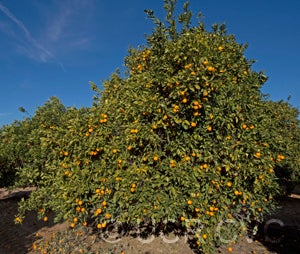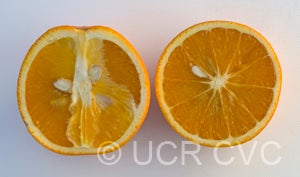Citrus sinensis (L.) Osbeck RUTACEAE
CRC 3873
PI 539636
Source
Received as seed from USDCS 54-81, Indio, CA, 1961.
Parentage/origins
Parson originated as a chance seedling in the dooryard of Rev. N. L. Brown near Webster, Florida, and is said to have been planted in 1856 (Ziegler and Wolfe, 1961). The propagation rights were purchased about 1875 by J. L. Carney, who named it Parson Brown.
Rootstocks of accession
Carrizo citrange, C-35 citrange
Season of ripeness at Riverside
January to March
Notes and observations
Six seedlings fruited at Lindcove; all appeared identical.
2/8/1988, EMN: A typical mid-season seedy sweet orange that is seedier than most sweets in the collection.
Description from The Citrus Industry Vol. 1 (1967)
"Fruit medium-large, globose; base with short, radial furrows; areole indistinct; moderately seedy. Well-colored under favorable conditions. Rind medium-thick; surface finely pitted and moderately pebbled. Flesh color dull orange; firm, juicy; well-flavored. Very early in maturity, possibly the earliest.
Tree vigorous, large, and productive. Its outstanding earliness soon popularized this variety and it quickly became the leading early orange, a position held until about 1920. Parson still remains a major variety in Florida, however, though it has never achieved prominence elsewhere, principally because of seediness."
Availability
Not commercially available in California.
USDA Germplasm Resources Information Network page for Parson Brown sweet orange


